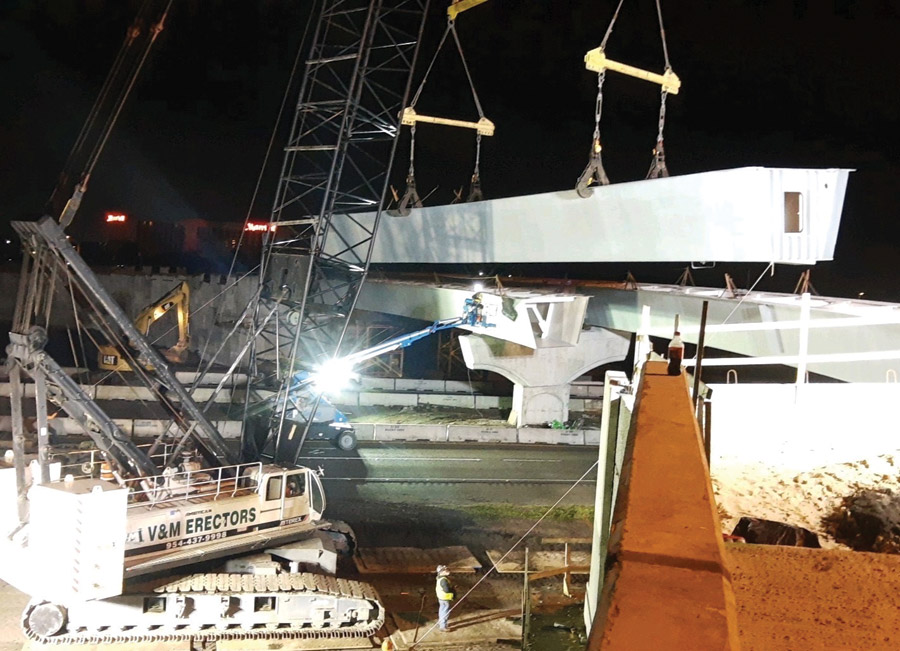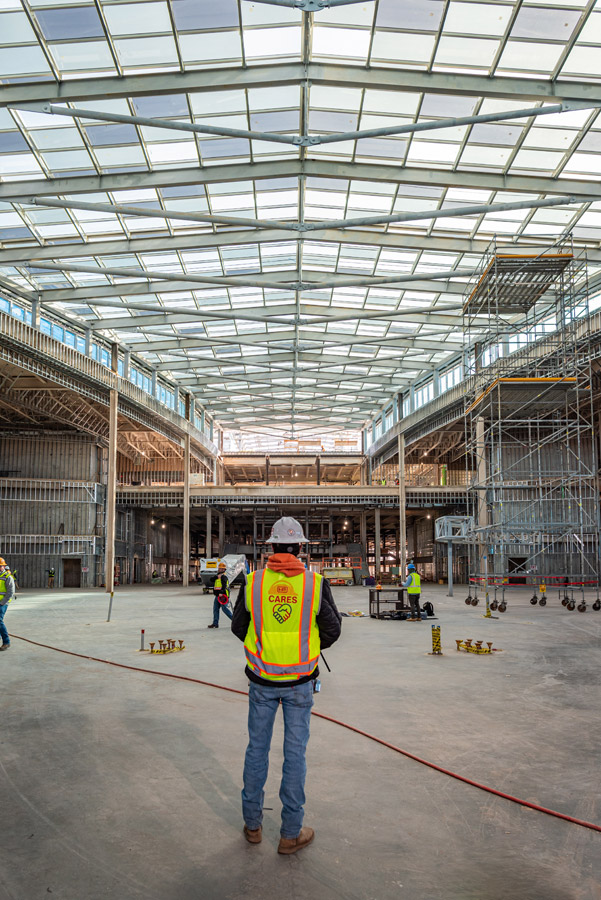Cover Story | Infrastructure
For Orlando, A Multimodal Transportation Infrastructure Makeover
_ENRready900.jpg?1646244143)
Photo courtesy of MCO
The greater Orlando, Fla., area is well-known for harboring a number of amusement parks and other attractions that bring tourists flocking into Orlando International Airport and through the local transportation system. But for the past several years, the main attractions for construction buffs have been at the airport itself.
A new south terminal, a higher-speed rail system and a rebuilt interchange altogether will represent over $3 billion in transportation infrastructure that will transform Orlando’s “welcome mat” for arriving visitors. The nearly $3-billion south terminal, the more than $600 million in adjacent rail work and the $113-million interchange in front of the airport all are in substantial completion, and each project features a variety of striking highlights in aesthetics, challenges and construction feats.
“The nation’s seventh-busiest airport, Orlando International Airport [MCO] is a major economic engine for our region,” says Tim Giuliani, president and CEO of the Orlando Economic Partnership. The group says that the area has the second-fastest growing population among the nation’s 30 largest cities, with an average of 1,000 new residents a week.
“As business and leisure travel continues to take off this year and next, the Orlando region’s infrastructure investments in and around MCO advance our region toward an integrated, multimodal, regional transportation system that meets the needs of residents, visitors and businesses—while also providing a foundation for a future of enhanced quality of life and broad-based economic prosperity,” says Giuliani.

New south terminal at airport will help accommodate a surfeit of travelers.
Photo courtesy of GOAA
Reaching New Heights
When it opens this summer, the 1.3-million-sq-ft South Terminal will be the world’s first LEED v4 airport campus, and the first in the U.S. to have a terminal-wide high-speed individual carrier system (ICS), while boasting 15 gates to handle more than 3 million extra annual passengers flying internationally.
“This job is epic in so many ways,” says Davin D. Ruohomaki, senior director of engineering and construction with the Greater Orlando Aviation Authority. After the pandemic hit, GOAA in May 2020 scaled back its original $3-billion budget for 19 gates at the terminal by more than $200 million. At the time, construction was about 60% complete. The airport negotiated changes with its two major construction-managers-at-risk, Hensel Phelps and a joint venture of Turner-Kiewit.
Bill Brooks, aviation director for the southeast region with HNTB, says the pandemic heightened the importance of incorporating flexibility into the terminal. HNTB is the architect of record, working with design architect Fentress Architects and GOAA’s general consultant SchenkelShultz.
The common-use terminal features facial recognition, automated screen lanes in which tubs used to hold screened items automatically return to the front of the line, and radio frequency identification devices to track bags. The ICS tote system, delivered by Vanderlande, has been used in Europe and Canada, but not, until recently, in the U.S. It will provide 30% energy savings and 50% labor savings, says Ruohomaki.

Seven new bridges and staggered tree canopies will provide increased capacity and make a striking impression on visitors leaving the airport.
Rendering courtesy of CFX

Photo courtesy of CFX
The terminal will also have the capacity to store 2,000 bags. “A lot of tourists would be sitting in the airport for hours schlepping big bags around,” says Brooks. “Now they can check bags any time more than three hours in advance.” The robotic system will automatically send bags to the right plane.
Terminal C also features recycled and preserved trees, interactive art and a layout in which international passengers enter on the top level. “During the whole process, they will have access to exterior light and see into the concourse,” says Ruohomaki.
Another striking architectural feature is the “prow,” a 66,000-lb arched element atop the roof entrance and cantilevered out 50 ft, says Jeff Justen, vice president with Turner Construction. Turner-Kiewit’s $1.4-billion contract includes the 816,000-sq-ft landside terminal, 240,000-sq-ft ground facility, a 6-floor parking garage, jet bridges and airfield paving.
To support the prow, crews built four 26-in.-dia columns weighing some 90,000 lb each. Phase two included installation of a “mini-prow” or the upper support steel for the glass curtain wall below the prow. In phase three, crews installed the steel backstays directly connecting to the steel columns. The prow was welded on the ground, then lifted into place as part of the topping out for the landside terminal in 2020.
“This [south terminal] job is epic in so many ways.”
Davin Ruohomaki, senior Director of engineering and construction, GOAA
Hensel Phelps is building the airside half of Terminal C, which includes a virtual ramp control system and remote monitoring systems to direct aircraft in and out of gates. The team worked closely with Turner-Kiewit to tie the two halves together on multiple floors. “We’re two very large builders tied at the hip,” says Matt Krstolic, Hensel Phelps’ program manager. In 2017, GOAA parted ways with the original contractor after a few months, and HP picked up the reins. “Our history with GOAA goes back to the late 1990s,” Krstolic notes.
The terminal’s 1,000-ft-long “boulevard” features a skylight that diffuses natural light throughout the space. Two huge screens in the central area will display pictures sent in by tourists and shared throughout the airport as a Moment Vault. The Windows of Orlando has a glass handrail system with sound transducers to immerse passengers in Orlando scenery.
Both contractors made commitments to eight small business (SBE) partners. “GOAA’s statutory goals for small/disadvantaged and local/developing participation on the project were 20% and 4%, respectively, which for a project this size was going to be a tremendous challenge,” says Ed Wallace, vice president of P A Wallace & Associates, which provided management staffing and ongoing audits of small business participation. He notes that Hensel Phelps raised the goals to 25% and 6%. By project’s end, “we will have achieved total project participation of 33%.”
Traffic is rebounding—40.3 million passengers traveled through Orlando International Airport in 2021, up over 86% from 2020. In 2019, prior to the pandemic, MCO registered 50.6 million passengers. GOAA is already preparing for construction of the four gates that were put on hold, says Ruohomaki. Those will be able to simultaneously handle international and domestic flights, a first of their kind, he says. GOAA is also planning an overhaul of the north terminal.
The Future is Bright (line)
Late last month, Middlesex Corp. completed a 3.5-mile section of the Brightline rail extension between West Palm Beach and Orlando that terminates at the airport’s intermodal center, built as part of Turner-Kiewit’s contract. That section, Zone 2, is one of four zones in the $2.7-billion, 172-mile extension of the higher-speed rail line from West Palm Beach to Orlando.
“It’s not the largest of zones, but it’s among the most complex in construction,” said Michael Cegelis, Brightline’s executive vice president for infrastructure, in a YouTube video. The alignment crosses over airport roadways and passes under taxiways and the airport people mover track. Construction included a 1,700-ft-long trench, six box beam bridges, two underpasses, an interchange and a roundabout. Working around taxiway foundations and a high water table, crews used micropiles, says Jerome Hall, Brightline project engineer. The work included footings for a potential light-rail corridor.
Zone 1 consists of building a vehicle maintenance site and facility with Hubbard Construction Co. and Wharton-Smith Inc. Granite Construction and two subcontractors hold an approximately $550-million, 35-mile contract in Zone 3. In Zone 4, a team of Herzog, Stacy &Witbeck and Railworks holds an approximately $700-million contract to upgrade 129 miles of existing track, and Scott Bridge Co. is rebuilding the Loxahatchee Bascule Bridge.
While Zone 2 work was akin to threading a needle through one of the country’s busiest airports, Zone 3 included swamps, alligators and crossing Interstate 95. Richard Brown, Granite project executive, says work on Zone 3 between the city of Cocoa and the airport is more than 80% complete. Subs Ranger and Southland are building 16 miles and 8 miles of the overall 35 miles, respectively, while Granite is building five miles on either side. The alignment includes 104,000 linear ft of piles as deep as 160 ft, 504,000 cu yd of subsoil excavation, 42 miles of new track and 18 bridges, says Brown.
Much of the alignment sits on embankment running alongside SR 528, with bridges that have piers ready for a future second track.

Many Brightline bridges cross over swampy areas and have room for future second tracks.
Photo courtesy of the Roving Railfan via Youtube
The work included a hydraulic push of three precast concrete boxes weighing up to 4,600 tons to create a 31-ft-high, 43-ft-wide underpass beneath State Route 528 to accommodate two trains side by side while eliminating an at-grade crossing; it was the first such operation to be done under live traffic in the U.S. (ENR 4/12-19/21, p. 18).
One structure, the St. Johns River bridge, utilizes ultra-high-performance concrete (UHPC) to fill in 8-in. gaps between beams; the concrete achieves 21,000 psi compared to 8,000 psi, says Brown. Since UHPC is not widely used in the Southeast, “it was a challenge to educate testing facilities on how to perform tests and [use] equipment,” he adds.
The material was needed to handle the shear forces that the heavy trains will cause when crossing one side of the bridge, says Matt Carroll, Brightline assistant project manager.
Further east, an arch tunnel will take trains from the south side of 528 to the north. The 330-ft tunnel consists of 121 panels cast on site, says Carroll. The tunnel crown utilizes fiber-reinforced composites. Crews used a conveyor belt to carry almost 1 million cu yd of material over SR 538 to the tunnel. “That saved us 68,000 truck trips,” says Carroll.
Ryan White, Brightline project manager for trackwork/crossings, says all 156 crossings will be completed this year as part of the Zone 4 contract. In late 2019, the Florida Dept. of Transportation (FDOT) launched a rail safety initiative that includes “dynamic envelopes” at every rail crossing on state land. “We worked with FDOT to make the roadway profiles flatter and comply with constraints,” White says. While these standards apply to all rail systems in Florida, media reports have noted the Brightline system has been plagued by dozens of deaths since its inception, resulting from people trying to cross the tracks despite safety precautions.
Scott Dean, HNTB structures project manager, says 12 of 29 bridges are complete, 11 are under construction and another six are in the works. Crews are also driving 48-in.-dia steel pipe piles for a planned bascule bridge replacement across the Loxahatchee River. “The structural steel is fabricated in Alabama, assembled, disassembled and will be trucked to the site,” Dean says. “Reassembly will occur on a large temporary platform, and in May a large operation will rebuild it all in place,” he says. The total length is 583 ft, with the movable span at 55 ft. New foundations will be built. “The superstructure could carry double track, but we couldn’t get guarantees regarding the foundations,” he says. “The timber piles are embedded below the mudline, so we couldn’t inspect them.”
Crews will also rehabilitate a 1,200-ft bascule bridge over the St. Lucie River, replacing mechanical components, electrical equipment and monitoring house and ties, and adding a pedestrian walkway, Dean says.
Test train runs have begun to qualify crews along the corridor. Brightline holds a 99-year lease with FDOT and the Central Florida Expressway (CFX) along SR 528 and runs in a freight corridor. That SR 528 alignment culminates in yet another ambitious construction feat at the entrance/exit to the airport.

A 66,000-lb cantilevered arch provides signature look for terminal.
Photo courtesy of GOAA
Ramping It Up
CFX has expansions to existing roads and a new toll road planned to accommodate the region’s ongoing growth. One of those projects is the $118-million welcome mat taking shape rapidly next to Orlando International Airport.
The revamp and expansion of the SR 528/SR 436 interchange includes seven new bridges, transformation of old loop ramps, new signage and lighting. It will feature a striking landscaping design including staggered tree canopies and planter walls in a contract yet to be issued.
“It will be a welcome mat for visitors,” says Laura Kelley, CFX executive director. SEMA Construction holds the $106-million contract that was expected to take about 2.5 years and be completed by early 2023. However, the project is on track now for a summer 2022 completion. The contractor could win up to $2.7 million in incentives for completing the job up to 180 days early.
The upgrade is expected to ease congestion for some 50,000 daily vehicles moving between the airport and the region, which includes numerous tourist attractions and the convention center. “The four loop ramps built in the 1980s will be semi-directional flyovers,” notes Will Hawthorne, CFX director of engineering, adding that the project will add an additional lane in each direction of SR 528.
Not only is the traffic non-stop due to the proximity to the airport, but “driver familiarity is very low,” says Ben Dreiling, CFX director of construction and maintenance. “This is not a commuter route. It’s a 24/7 rush hour in and out of the airport.”
While the pandemic dramatically reduced traffic for a while, “we went from almost nil in 2020 back to full speed by 2021,” Dreiling adds. On average, nearly 150,000 vehicles pass through the airport each day, while 25,000 employees commute to the airport.
Mike Hill, SEMA senior project manager, says the team, which began work in 2020, took as much advantage of the temporary decrease as it could. “We focused on areas where we could incorporate longer durations of outages. We jumpstarted the project and tweaked the traffic control plan.”
After its board designated the interchange as a “project of critical concern,” CFX worked with GOAA to evaluate technical presentations of bidders. They then shortlisted them based on technical merit, schedule, budget and financial backgrounds, and had the shortlisted firms offer hard bids, says Dreiling.
The early completion incentive starts off at $10,000 a day for the first 30 days, then increases every 30 days after that, up to $20,000 a day. The same holds true in the opposite direction for late-completion penalties, plus liquidated damages, he adds. “It’s a big stick in back, and a big carrot in front.”
Six of the seven bridges are structural-steel tub girders due to curves, and the seventh is a concrete tub U-girder structure, says Hill. “We’ve worked 24/7 basically, excluding Saturdays, since we started. I can count on one hand the nights we didn’t work.”
Crews had to navigate in and around ponds and reconstruct nine of them to make room for the new flyovers while maintaining traffic, says Justin Oakes, vice president of SEMA. “It’s an aggressive accelerated schedule—$110 million of construction in 24 months.”
CFX had a “no excuses” approach, even with the pandemic. “Nothing sat on that job,” says Dreiling. “We never talked about time extensions. No weather days, COVID, materials shortages, price escalations—in every scenario, we took advantage of whatever pluses there were.”
But the agency worked as a partner to make the accelerated schedule possible, says Hill. “Every project has its challenges. What CFX did was put all parties on the same side of the table. We received priority on every submittal we had. If there were shop drawing issues, we had team meetings to iron them out.”

Spacious new Orlando airport terminal includes top-level corridor for international arrivals.
Photo courtesy of Hensel Phelps
The team also worked closely with Brightline. For example, “Brightline was getting into our right-of-way at a new ramp,” says Hawthorne. “Who comes first? Early on, we held weekly meetings with them. ‘You go or we go.’ We all had dirt in the same spot, at different elevations. It was a managed risk early on.” SEMA switched its maintenance of traffic plan and did median work first to accommodate Brightline.
SEMA is finishing up structural asphalt with friction course installation planned in May. “Our milestone completion date is August,” says Hill. “We hope to do even better than that by a month or so.”
The interchange is just the beginning of ambitious CFX plans. The first segment of a 5-mile greenfield Lake/Orange Expressway is nearing design completion. A one-lane, half-mile section will serve as a test pilot for in-road electric vehicle charging in conjunction with Utah State University, says Hawthorne. The new expressway will also aim for Envision certification.
Other planned projects include a 22-mile-widening of SR 417 and a 7-mile widening of SR 538 at Poinciana Parkway. As for the current interchange, an estimated $3-million contract for the landscaping architecture will be heading out to bid soon, says Hawthorne. “Typically it would be two years after construction.”
Noting the neighboring projects of Brightline and the airport’s south terminal, Dreiling says, “We were the last to the party, and we’ll be the first one done.”




